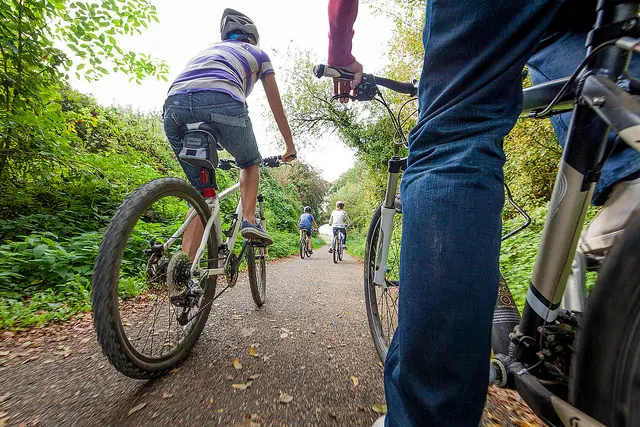Kathleen shares this latest news on behalf of Sustrans. Ed
The first ever UK-wide independent audit of the National Cycle Network calls for more investment to make it safer, accessible and more inclusive.
Commissioned and launched today (Monday) by walking and cycling charity Sustrans, the ‘Paths for Everyone’ report (see below) reveals the current condition of the 23-year-old Network.
Almost 4,000 miles reviewed
Of the 16,575-mile Network, over 3,700 miles are in the South of England, all of which was reviewed.
The review shows that while over half (57 per cent) of the UK population lives within a mile of the National Cycle Network, improvements are needed to enable everyone to use it, especially vulnerable users – including children, people with impaired mobility and the less physically active, as well as, people using adapted bikes, such as tandems, and parents with pushchairs.
55 projects highlighted
Working with local authorities, the report highlights 55 projects across the UK, including eight in the South of England – the Bristol & Bath Railway Path, Chilton Road in Upton, Oxfordshire, Leigh Road in Wimborne, Christ’s Hospital in West Sussex, the Kennet & Avon Canal, Ashton Court in Bristol, Reading Barriers and Misbourne Greenway in Buckinghamshire.
Each project highlights a range of issues including poor signage, barriers, dangerous junctions and uneven surfacing, as well as solutions for creating safe, accessbile and traffic-free paths. These are to be finalised by 2023.
Hugely important asset
Of the total Network in the South of England, 2,591 miles (68 per cent) is on-road and, of this, 233 miles are on A or B roads. The remaining 32 per cent, a total of 1,207 miles, is on traffic-free paths.
James Cleeton, Sustrans Director for the South of England said:
“The National Cycle Network is a hugely important asset for our region which is enjoyed by millions of users every year.
“In the South of England we are extremely proud of our National Cycle Network. We are fortunate to have second longest Network of all the UK regions and nations, with almost 3,800 miles of routes and paths, covering an area that stretches from Land’s End in the West, to the Isle of Wight in the South, the Isle of Thanet in the East and Banbury to the North.
“We also have some of the most iconic routes of the whole Network, including the Bristol and Bath railway path that sees over 2.5 million users every year, the Camel Trail in Cornwall, the Viking Coast Trail in North Kent and the 170 mile Eurovelo 2, a long distance route that links European capitals from Dublin to Moscow.
“Walking and cycling is good for us – it improves our health and well-being and contributes towards a cleaner and greener environment. Active travel and commuting tackles congestion, obesity and the air quality crisis. And while the health, economic and environmental benefits of the Network are well established, it is the vital role it plays in our local communities which is its real value.
“This review is our opportunity to secure the investment and commitment needed to make our National Cycle Network safer and more accessible for all users, creating paths that truly are for everyone and safeguarding its heritage for future generations.”
Reliably safe and accessible network needed
Isabelle Clement, director for the charity Wheels for Wellbeing, one of the organisations on the UK Advisory panel of the Network’s Review, said:
“Many disabled cyclists use parts of the National Cycle Network, whether on bikes, tandems, hand-bikes or trikes.
“But we are too often limited in the cycling we can do by the inconsistent quality of paths, the presence of stiles, stepped bridges, etc., which literally block our path.
“Transforming the National Cycle Network into a reliably safe and accessible network over the next few years will make a huge difference to disabled people’s ability to access the outdoors, travel actively and improve our wellbeing.”
National Cycle Network
The National Cycle Network, which was founded by Sustrans, with the help from local communities, partners and the National Lottery grant awarded in 1995, is a critical part of the UK transport infrastructure.
Every year over 780 million journeys are made on the Network which links towns, villages and cities across the country.
In the South of England the Network runs through four National Parks and connects with the major towns and cities of Plymouth, Bristol, Swindon, Bournemouth, Poole, Southampton, Portsmouth, Oxford, Reading, Aldershot, Brighton & Hove and the Medway towns.
The Survey
An online survey of 5,965 UK residents shows overwhelming support for the Network, with 81 per cent of the respondents saying they want paths built away from cars where everyone feels safe to travel.
The “Paths for Everyone” report is the conclusion of a major review and independent audit commissioned by Sustrans. The review involved interested stakeholders and sets out 15 recommendations for local authorities, private and charitable landowners, national governments and agencies, to transform the Network, including:
- Removal or redesign of 16,000 barriers on the entire Network to make it accessible to everyone, especially those facing mobility challenges;
- Doubling the number of paths away from cars, from 5,000 to 10,000 miles and diverting all routes off busy and fast moving roads onto new quiet-way roads;
- Improving safety at junctions where the Network crosses roads and railways;
- Improving signage so everyone can follow the paths without a map or smartphone;
- Adopting a new quality design standard for paths, including width and surface so all routes are classed as ‘very good’ or ‘good’ by 2040.
Major piece of transport infrastructure
Whilst the National Cycle Network has the potential to help people live healthier lives, Sustrans argues it should also been seen as a major piece of transport infrastructure with untapped economic potential.
The charity, which owns 500 miles of the Network, has estimated the overhaul will double the number of people travelling actively – be it on foot, by bike or in a wheelchair – up to 8.8 million, totalling a £2.8 billion investment over the next 22 years.
These trips will generate £7.6 billion in economic and local benefits every year, as a result of reduced road congestion and health benefits from increased exercise, including £5 billion alone in benefits to local businesses from tourism and leisure – up from £3.8 billion per year in 2017.
‘Paths for Everyone’
Click on the full screen icon to see larger version.
Image: © Visit Isle of Wight





